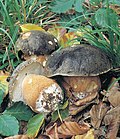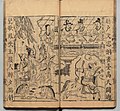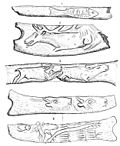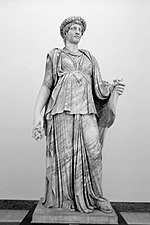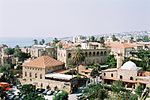Cornucopia (redirect from Horn of abundance)
-n(j)uː-/; from Latin cornu 'horn' and copia 'abundance'), also called the horn of plenty, was a symbol of abundance and nourishment, commonly a large horn-shaped...
15 KB (1,541 words) - 03:01, 24 October 2024
Dōtaku (redirect from Bronze bell)
create the appearance of raised bronzes on the outer surface. Many of these sandstone moulds were "found in abundance in northern Kyushu" and near Kyoto...
12 KB (1,403 words) - 06:37, 17 October 2024
and geochemistry at the University of Arizona, has measured elemental abundances in meteorites as a means of probing the early history of the solar system...
172 KB (470 words) - 06:46, 8 November 2024
The island bronze-naped pigeon (Columba malherbii), also known as the São Tomé bronze-naped pigeon or São Tomé pigeon, is a species of bird in the pigeon...
16 KB (1,972 words) - 20:38, 30 November 2023
The giant bronze gecko (Ailuronyx trachygaster) is a species of lizard in the family Gekkonidae endemic to Seychelles. Its natural habitats are subtropical...
3 KB (361 words) - 18:52, 12 January 2024
Ages of Man (redirect from Bronze Age (mythology))
did not have to work to feed themselves, for the earth provided food in abundance. They lived to very old age but with a youthful appearance and eventually...
8 KB (1,026 words) - 16:53, 4 August 2024
Canaan (section Early Bronze Age (3500–2000 BC))
millennium BC. Canaan had significant geopolitical importance in the Late Bronze Age Amarna Period (14th century BC) as the area where the spheres of interest...
128 KB (14,830 words) - 22:07, 8 November 2024
Dui (vessel) (redirect from Dui (Bronze vessel))
A dui is a type of Chinese ritual bronze vessel used in the late Zhou dynasty and the Warring States period of ancient China. It was a food container used...
9 KB (1,049 words) - 15:34, 23 January 2024
Eutropis macularia (redirect from Bronze Mabuya)
The bronze grass skink, bronze mabuya or speckled forest skink (Eutropis macularia), is a species of skink found in South and Southeast Asia. It is a common...
7 KB (789 words) - 05:46, 21 March 2024
Flag Fen (redirect from Flag Fen Bronze Age Centre)
Must Farm Bronze Age settlement. Log boats recovered there are preserved and displayed at Flag Fen. Flag Fen is also home to an abundance of wildlife...
18 KB (1,937 words) - 15:31, 8 June 2024
Metal (section Abundance and occurrence)
thereafter as a result of a neutron star merger, thereby increasing the abundance of elements heavier than helium in the interstellar medium. When gravitational...
94 KB (11,220 words) - 14:45, 6 November 2024
Boletus aereus (redirect from Bronze bolete)
Boletus aereus, commonly known as the dark cep, bronze bolete, or queen bolete, is a highly prized and much sought-after edible mushroom in the family...
33 KB (3,368 words) - 05:00, 19 February 2024
The Bronze Bird Terrace (traditional Chinese: 銅雀臺; simplified Chinese: 铜雀台; pinyin: Tóngquètái) was an iconic structure in the city of Ye built in AD 210...
27 KB (3,542 words) - 03:27, 6 August 2024
identifiable trail marker trees once stood clearly marking the route north. The abundance of trail marker trees in the Great Lakes region was a direct result of...
21 KB (2,955 words) - 17:50, 8 November 2024
Prehistory (section Bronze Age)
Once the technical challenge had been solved, iron replaced bronze as its higher abundance meant armies could be armed much more easily with iron weapons...
56 KB (5,895 words) - 17:42, 3 November 2024
Archaeology of Northern Europe (section Bronze Age)
Indo-European expansion. The Nordic Bronze Age proper began roughly one millennium later, around 1500 BC. The end of the Bronze Age is characterized by cultural...
23 KB (2,460 words) - 00:30, 11 October 2024
Sumer (category Bronze Age civilizations)
valleys of the Tigris and Euphrates rivers, Sumerian farmers grew an abundance of grain and other crops, a surplus which enabled them to form urban settlements...
110 KB (12,485 words) - 21:40, 30 October 2024
Prehistoric religion (redirect from Bronze and Iron Age religion)
Pickering TR, Menter CG, Heaton JL (2 April 2018). "Hominin skeletal part abundances and claims of deliberate disposal of corpses in the Middle Pleistocene"...
164 KB (19,622 words) - 02:05, 15 October 2024
from the East" theory, says the proto-Celtic language arose in the late Bronze Age Urnfield culture of central Europe, named after grave sites in southern...
149 KB (16,668 words) - 13:33, 6 November 2024
Ascalon (category Bronze Age sites in Israel)
with evidence of city fortifications emerging in the Middle Bronze Age. During the Late Bronze Age, Ashkelon was integrated into the Egyptian Empire, before...
71 KB (8,723 words) - 20:24, 5 November 2024
wear three thousand years ago?]. 天府广记 [Extensive Records of the Land of Abundance] (in Simplified Chinese). No. 3. Chengdu: Chengdu Committee of the Chinese...
5 KB (472 words) - 04:39, 8 March 2024
accepted as a symbol of abundance and a sacred fruit of ancient Kurdish religions. Pomegranate is used as a symbol of abundance in Kurdish carpets. Pomegranate...
64 KB (6,623 words) - 22:11, 5 November 2024
Pomona (/pəˈmoʊnə/ , Latin: [poːˈmoːna]) was a goddess of fruitful abundance and plenty in ancient Roman religion and myth. Her name comes from the Latin...
9 KB (918 words) - 19:45, 26 September 2024
use NMR analysis with for samples containing isotopes at their natural abundance. "Standard Atomic Weights: Tin". CIAAW. 1983. Prohaska, Thomas; Irrgeher...
81 KB (8,855 words) - 20:28, 5 November 2024
(low-grade steel coated with zinc, instead of the previously 95%-copper-based bronze composition) has led to various nicknames, such as wartime cent, steel war...
17 KB (1,795 words) - 12:15, 31 October 2024
shown to have a long tradition. The abundance of different cultural elements that persisted towards the end of the Bronze Age, show a clear continuity of...
165 KB (19,249 words) - 16:30, 4 November 2024
so named for its relief depicting an attack on a fortified town. The abundance of precious metalwork and weaponry both votive and practical discovered...
1 KB (158 words) - 23:55, 2 October 2023
did not have to work to feed themselves for the earth provided food in abundance. They lived to a very old age with a youthful appearance, eventually dying...
27 KB (3,585 words) - 01:53, 7 November 2024
Byblos (section Early Bronze)
hill was too small to have been the seat of a city such as Byblos. The abundance of ancient fragments collected around the citadel, the situation of the...
45 KB (4,638 words) - 12:51, 22 October 2024
at least six important factors: The Lunar phase (a waxing moon meant abundance and growth, while a waning moon was associated with decline, conservation...
90 KB (10,458 words) - 05:52, 21 October 2024











